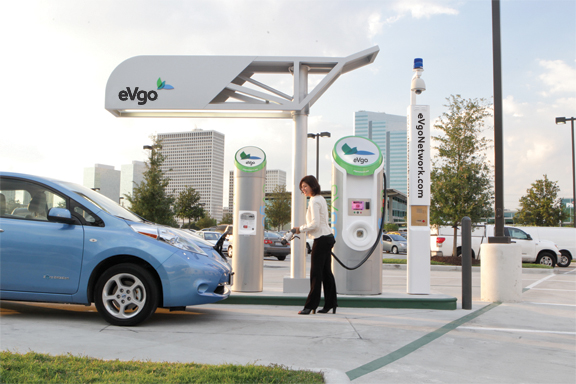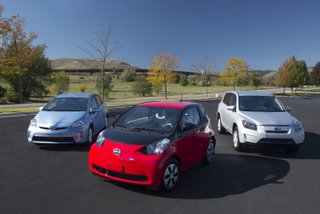
For the past 18 months, my wife and I have been driving the all-electric Nissan Leaf. The official EPA range rating is 73 miles, but at times we have driven over 100 miles roundtrip before returning home to charge in our garage. The secret is that we averaged 40 miles per hour (mph). When driving at freeway speeds with more demand from the electric motor and more wind resistance, we try to avoid traveling over 60 miles.
In 18 months, we have never reached empty. The big reason is that like most owners of all-electric cars, we have two cars. The person who plans to drive the most miles, but less than 60, takes the Leaf. Most all-electric car owners have two cars in their household.
Range is also extended because I live in California where there are over 2,000 public charge points. A few times monthly, I take the Leaf beyond its 60 mile freeway range and use Google Maps, the Leaf navigation, or smart apps to find a nearby place to charge. Typically 60 to 90 minutes is the Level 2 charge time I need to get home. When lucky the charge points are at my meeting site, or close to a nearby café. When very lucky, the charge station provides DC fast charge where I can charge to 80 percent in a matter of minutes.
New Electric Cars Offer Better Range than the Nissan Leaf
Smaller, lighter, electric cars with battery chemistry and power management allow electric car drivers to go further. Dr. Andrew Burke easily gets 100-mile range around Davis with his new Honda Fit Electric. Dr. Burke is recognized as one of the world’s experts in energy storage. In 1976, he actually built one of the world’s first plug-in hybrid vehicles.
In city driving, taking advantage of the “Econ” mode and regen, Dr. Burke only uses a fraction of the Fit EV’s 20 kW Toshiba lithium battery to reach 100 electric miles. His driving efficiency of up to 6 kilowatts (kW) per mile, exceeds the EPA rated at 29 kilowatt-hour (kWh)/100 mile, better than the Nissan Leaf which is rated at 34 kWh/100 miles.
The Fit EV weighs only 3,252 pounds which helps it achieve great range than my larger Nissan Leaf with 3,401 pounds. The new BMW i3 and i8 will extend range by using super-strong, yet lightweight materials including aluminum frame and carbon fiber reinforced plastic, or CFRP for short. The i3 body consists of two independent modules: the Drive Module consists of an aluminum chassis and the powertrain with the lithium-ion battery, the performance electronics and a compact but powerful electric motor.
The Tesla Model S Sedan with optional 85-kW battery pack has a stunning 265-mile range. This beautiful all-electric 5-seat sedan shows us what is possible for $79,000. Lithium battery packs cost car manufacturers half what they did four years ago. Electric cars become far more popular as improved design, chemistry, and volume manufacturing lowers price. The Mitsubishi I starts at $29,145 before incentives and saves many $1,500 per year in fuel and maintenance.
This year, 600,000 hybrid and electric cars will use advanced batteries. In 2013, Clean Fleet Report forecasts global sales of one million hybrid and electric cars that use advanced batteries, electric motors, and electric drive system components. Volume is driving better cars and lower costs.

Most hybrids are from Toyota using NiMH batteries. By 2015, Toyota will be selling 21 new hybrids; some models may use the lithium batteries technology now used in Toyota’s four electric cars, all of which I have driven. Honda, Ford, Hyundai and others have already switched to lithium for their hybrids.
Plug-in Hybrid Sales are Triple All-Electric in USA

All-electric car drivers need to pay attention to range; plug-in hybrid drivers find their range extended hundreds of miles with a fill-up at the nearest gas station. Hybridcars.com reports the following U.S. sales for the first nine months of 2012:
- Chevrolet Volt 16,348
- Toyota Prius Plug-in Hybrid 7,734
- Nissan Leaf 5,212
Drivers of the Chevrolet Volt travel in all-electric mode for 35 to 40 miles, then an efficient gasoline engine extends range to 380 miles. Volt drivers that regularly charge at home, work, and public charge points rarely add gasoline. But for the long trips, their car will get them there with the efficiency of a hybrid car with good MPG.
In the near future, we will see more exciting plug-in hybrids from Ford, GM, BMW, Honda, and probably from Toyota.
Battery Innovation Continues to Extend Range and Lower Cost
Lithium batteries are rapidly improving on a number of dimensions including power, energy, cost, size, and weight. Cell chemistry is improving. Perhaps of equal importance power electronics and control software is improving to improve energy and battery life. Major research is being conducted in these forms of energy storage:
- Solid State Batteries
- Lithium Air
- Zinc Air
- MgS
- New Chemistries
- Hybrid Ultracapacitor-Batteries
All-electric cars in Israel, Denmark, and taxi fleets in several countries extend their range with Better Place robotic switching stations. A taxi running on empty pulls into the station where the empty battery is robotically replaced with a full battery. Five minutes later, the driver is back on the road.
Hydrogen fuel cell vehicles are being used in transit buses, big forklifts, and fleet operations that can afford to install their own hydrogen station. The hydrogen fuel cell generates enough electricity for the electric vehicle to go over 300 miles. The 20 hydrogen fuel cell buses used in the Vancouver Winter Olympics now have one million passenger miles. Mercedes, Honda, Toyota, GM and others plan on 2015 vehicles for commercial sales and leases to fleets and test geographies. The Hyundai Tucson FCV has 3 forms of energy storage: lithium batteries, hydrogen PEM fuel cell, and ultracapacitors.
Electric vehicles are now bought and leased at the same rate as the early years of the Prius. About 20,000 electric cars were sold in 2011, 60,000 in 2012. In 2013, sales are likely to again triple to about 180,000. By 2014, Clean Fleet Report forecasts that one million vehicles will be sold with lithium battery packs.
Range is not the “show stopper” that critics have claimed. All-electric cars fit in fine in two car households and with solo city drivers that have access to transit, car sharing, and car rental. Battery innovation continues to make hybrid and electric cars go farther at lower cost. Plug-in hybrids are now leading because of the convenience of electric charging at home and gasoline fill-ups when needed.
Best All-Electric and Plug-in Hybrid Cars
